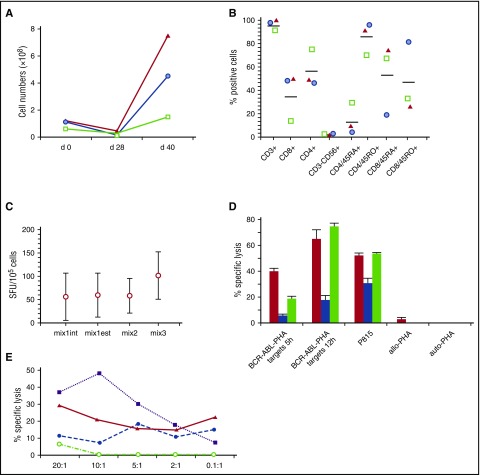Figure 1.
Characteristics of the p190BCR-ABL–specific T cells used in the 3 patients. (A) T-cell expansion of p190BCR-ABL–specific T-cell lines achieved over a 40-day period based on cell counting using trypan blue exclusion (green square, patient 1; blue circle, patient 2; red triangle, patient 3). (B) Phenotype of p190BCR-ABL–specific T-cell lines, reported as the percentage of positive cells (green square, patient 1; blue circle, patient 2; red triangle, patient 3). (C) Response, measured as IFNγ production in a enzyme-linked immunospot (ELISPOT) assay, to the different peptide pools used in the activation/expansion process. Mix1int indicates 9- and 10-mer peptides spanning the internal p190 breakpoint region; Mix1est, 9- and 10-mer peptides spanning the external p190 breakpoint region; Mix3, 9-mer peptides derived from the alternative BCR-ABL splice variants. (D) Cytotoxic activity of T-cell lines, measured as the percentage of specific lysis at a effector-to-target (E:T) ratio of 5:1, against autologous phytohemagglutinin (PHA) blasts pulsed with p190BCR-ABL peptides (BCR-ABL-PHA targets, cytotoxicity measured at 5 hours and 12 hours, calculated after subtraction of background, consisting of cytotoxicity against autologous PHA blasts pulsed with irrelevant peptides), P815 cell line, nonpulsed PHA blasts from patients 1 and 2 (allo-PHA), nonpulsed autologous PHA blasts (auto-PHA) (red column, patient 1; blue column, patient 2; green column, patient 3). (E) Cytotoxicity profile of p190BCR-ABL–specific CTLs obtained from patient 2. The figure reports the percentage of specific lysis against patient ALL blasts (solid line and triangle), autologous PHA blasts pulsed with p190BCR-ABL peptides (dashed line and solid circle), P815 cell line (dotted line and solid squares), nonpulsed PHA blasts of the patient (dashed-dotted line and empty circles). The mean percentage of lysis of duplicate wells for 5 different E:T ratios is shown. SFU, spot-forming unit.

